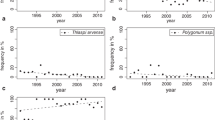Abstract
The adverse effect of the parasitic weed Striga hermonthica on yield of maize was studied in a fertilizer trial in Southwestern Kenya. In two years of experimentation (1987 and 1988), the weed had a highly significant, negative impact on maize yields. The spotty incidence of Striga disturbed the fertilizer trials. Inclusion of the degree of Striga infestation in a regression model caused an increase in the fraction of experimental variation that could be explained by the model.
Several methods were tested to combat Striga. Hand-pulling reduced Striga incidence and increased grain yields during the following growing season. No clear effect was obtained from the trap crop sunflower, although such an effect may have been concealed by the success of hand-pulling. Application of mineral fertilizers or farmyard manure did not significantly reduce Striga infestation.
Similar content being viewed by others
References
Agabawi K A and Younis A S 1965 Effect of nitrogen application on growth and nitrogen content of S. hermonthica, Benth. and Sorghum vulgare, Lur. grown on forage. Plant and Soil 23, 295.
Bebawi F F 1987 Cultural practices in witchweed management. In Parasitic Weeds in Agriculture, Volume I: Striga. Ed. L J Musselman. p 159. CRC Press, Boca Raton, FL.
Bebawi F F and Farah A F 1981 Effects of patterns and methods of sowing on sorghum/Striga relations. Exp. Agric. 17, 337.
Carson A G 1989 Research and development strategies for the control of Striga hermonthica in the Gambia. In Striga-improved Management in Africa. pp 101–118. FAO, Plant Production and Protection paper 96.
Doggett H 1988 Witchweed (Striga). In Sorghum, 2nd ed. Ed. G Wirgley pp 368–404. Longman Sc and Tech, London/Wiley, New York.
Efron Y, Kim S K, Parkinson V and Bosque-Perez N A 1989 IITA's strategies to develop Striga resistant maize germplasm. In Striga-improved Management in Africa. pp 141–153. FAO, Plant Production and Protection paper 96.
Enserink H J 1982 Sorghum agronomy investigations in Western Kenya. UNDP Assignment Report KE/78/016, Busia, Kenya.
FAO 1988 FAO-Unesco soil map of the world: Revised legend. World Soil Resources Report 60. FAO, Rome, Italy.
FAO 1989 Striga-improved Management in Africa. Plant Production and Protection paper 96.
Gomez K A and Gomez A A 1984 Statistical Procedures for Agricultural Research, Wiley, New York.
Hosmani M M 1978 Striga, a noxious root parasitic weed. Royal Printers and Univ. Agric. Sciences, Bangalore.
Last F T 1961 Direct and residual effects of Striga control treatments on sorgum yields. Trop. Agric. 38, p. 49.
Laycock D 1989 Recent results of Striga investigations in the CILSS integrated pest management project with special reference to Niger. In Striga-improved Management in Africa. pp 119–135. FAO, Plant Production and Protection paper 96.
Ogborn J E A 1984 Research priorities in Agronomy. In Striga Biology and Control. Eds. E S Ayensu et al. p 195. Int. Council of Scientific Unions Press, symposium series no. 2, Paris.
Ogborn J E A 1987 Striga control under peasant farming conditions. In Parasitic Weeds in Agriculture, Volume I: Striga. Ed. L J Musselman. p 145. CRC Press, Boca Raton, FL.
Osman M A, Raju P S and Peacock J M 1991 The effect of soil temperature, moisture and nitrogen on Striga asiatica (L.) Kuntze seed germination, viability and emergence on sorghum (Sorghum bicolor L. Moench) roots under field conditions. Plant and Soil 131, 265–273.
Parkinson V, Kim S K, Efron Y, Bello L and Dashiell K 1989 Potential trap crops as a cultural measure in Striga control for Africa. In Striga-improved Management in Africa. pp 136–140. FAO, Plant Production and Protection paper 96.
Smaling E M A and Van de Weg R F 1990 Using soil and climate maps and associated data sets to select sites for fertilizer trials in Kenya. Agric. Ecos. Envir. 31, 263–274.
Snedecor G W and Cochran W G 1980 Statistical Methods, 7th ed. Iowa State Univ. Press, Ames.
Soil Survey Staff 1975 Soil Taxonomy, a basic system of soil classification for making and interpreting soil surveys. Agric. Handbook 436. USDA, Washington, DC.
Vasudeva Rao M J, Chidley V L and House L R 1989 Estimates of grain yield losses caused in sorghum (Sorghum bicolor L. Moench) by Striga asiatica (L.) Kuntze obtained using the regression approach. Agric. Ecos. Envir. 25, 139–149.
Watt W L 1936 Control of Striga weed in Nyanza Province, Kenya. East Afr. Agric. For. J. 1, 320.
Author information
Authors and Affiliations
Rights and permissions
About this article
Cite this article
Smaling, E.M.A., Stein, A. & Sloot, P.H.M. A statistical analysis of the influence of Striga hermonthica on maize yields in fertilizer trials in Southwestern Kenya. Plant Soil 138, 1–8 (1991). https://doi.org/10.1007/BF00011801
Received:
Issue Date:
DOI: https://doi.org/10.1007/BF00011801




